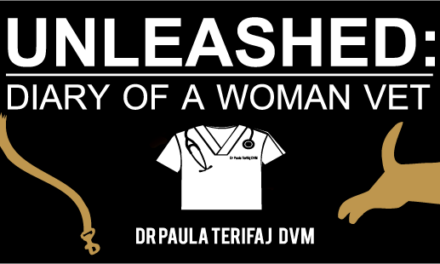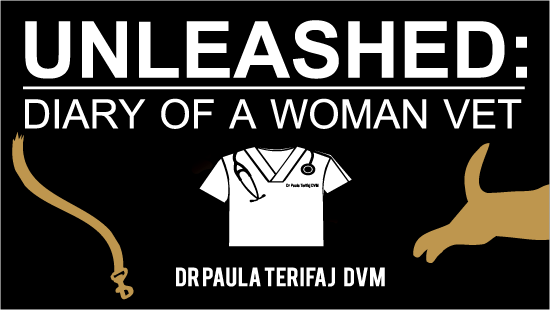Chapter 16
Brad Pit
“Opinion is the medium between knowledge and ignorance.”
– Plato
If I had to guess, the rescued dog was a fifty-fifty split – half beagle and the other half spilling into the murky “pit bull” waters. And I’d probably be right. The kind stranger who took him off the streets named him Brad Pit. He was a handsome boy, so the name proved quite fitting. However, when I first laid eyes on him, he was a very sick dog that would reveal his prince charming side later. In fact, he was a pitiful mess (pun intended). As a favor to a friend, I drove out to see him. I had been told that the antibiotic was not working. Not an uncommon problem. Maybe I would just need to switch up his meds. So, I was shocked to see a hairless dog that looked more like the shell of a lobster. He had a patchy red glow like his fur had been seared off to expose raw skin. Both ear canals swollen shut and oozing purulent material (fancy name for puss). He looked so painful, I thought he might try to bite as I approached. But all this smelly dog did was wag his tail when I looked at him. It was a jaw dropping teary-eyed moment.
I had to convince the well-meaning but clueless rescue guy to let me treat Brad Pit (BP) at my hospital. So, I made an offer he could not refuse – all veterinary care at no cost. It was literally a matter of life or death for the dog. I think he may have suspected as much. BP’s treatments would become an intense two-month rehabilitation. Fortunately, I had enlisted the help of my dedicated staff. Weeks of daily skin care included soaks with medicated shampoos, ear flushes, and multiple antibiotics to fight the infection. Although BP showed modest improvement, he was not making the real progress I expected. What puzzle piece was I missing? On occasion, I refer patients to a nearby top-notch veterinary dermatologist. This time I referred my rescue dog, BP. It was our second car trip together. As I drove, my smarty pants inner veterinarian reduced herself to humble doctor status. On the bright side, I’m always an eager student. The experience would make me a better doctor. And it surely did.
Dr WR nailed it on the history and visual exam. I was about to get my first crack at treating a flesh crawling bacterium that I had only read about. A deadly bacterium called MRSA: Methicillin-resistant Staphylococcus aureus. The typical (and easily treated) staph infection had morphed into an atypical new smart bug. MRSA is a virulent bacterial strain that renders many of the antibiotics commonly used against it useless. When MRSA spreads from the skin to invade vital organs, the patient’s life starts ticking on a medical stopwatch. In a race against time, the search is on to find a bigger, more powerful gunslinger. This devil makes headline news, naming its human casualties.
The frightening possibility that our professors warned us about in pharmacology class. MRSA was the real-life prediction coming true – the hatching of super bugs. We understood that what sounded like science fiction, was not, although none of us wanted to believe it. We were warned that the continued indiscriminate use of antibiotic wonder drugs was a breeding ground for antibiotic resistors. The message was clear. Antibiotics had unintended consequences. These powerful drugs should never be used until there is a reasonable diagnosis. Don’t treat symptoms. Don’t be that doctor.
Bacteria live on an evolutionary fast track, so germs that survive treatment with one antibiotic soon learn to resist others. Once upon a time, common infections caused by Staphylococcus aureus were wiped out with good old fashion penicillin. Not anymore. The heartbeat of evolution beats on to insure enhanced survival. So, when microscopic single-celled organisms were gifted genetic resistance, a bacterial Frankenstein was unleashed.
Methicillin is a semisynthetic form of penicillin. Our love affair with penicillin dates back to the 1940’s. Its discovery led to magic bullet treatments that battled a wide range of infections – helping doctors to save countless lives. Forty years after the penicillin era began, our professor’s stern warnings about doctors writing lazy prescriptions was the harbinger of a medical disaster. Now, we keep chasing super bugs with more sophisticated and costly antibiotics. Modern medicine has entered a new war against microbes. An enemy so small they cannot be detected with the naked eye. Its irrelevant size says nothing of its power to kill. BP was on a bacterial hit list.
Three days later, a skin culture confirmed Dr WR’s diagnosis. Resistant bacteria had invaded Brad’s deeper layer of skin tissues. His culture was positive for MRSA. Puzzle solved. Second opinions can be lifesaving. A second opinion saved Brad Pit. Before his treatment ended, I would fall in love again. This time with a Denver outlaw that greeted everyone with a tail wag and loved to lick my toes. People scare me, not dogs.






